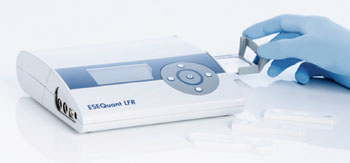Lateral Flow Assay Detects Leprosy Immune Response
By LabMedica International staff writers
Posted on 22 May 2014
Field-applicable tests detecting asymptomatic Mycobacterium leprae infection or predicting progression to leprosy are urgently required to determine both cellular and humoral immunity.Posted on 22 May 2014
Leprosy, a curable infectious disease caused by M. leprae that affects the skin and peripheral nerves, is one of the six diseases considered as a major threat in developing countries as continued transmission in endemic areas likely occurs from the large reservoir of individuals who are infected subclinically.
Infectious disease specialists at the Leiden University Medical Center (The Netherlands) with colleagues in Ethiopia recruited for their study human immunodeficiency virus (HIV)-negative, newly diagnosed untreated leprosy patients, and healthy endemic controls from October 2011 until November 2012. Leprosy was diagnosed based on clinical, bacteriological and histological observations and classified by a skin biopsy.
The combined diagnostic value of interferon (IFN)-γ induced protein 10 (IP-10), interleukin-10 (IL-10) and anti-Phenolic Glycolipid-I (PGL-I) antibodies was tested using M. leprae-stimulated blood of leprosy patients and endemic controls (EC). For reduction of the overall test-to-result time, the minimal whole blood assay time required to detect distinctive responses was investigated. To accommodate Lateral Flow Assays (LFAs) for field settings, dry-format LFAs for IP-10 and anti-PGL-I antibodies were developed allowing storage and shipment at ambient temperatures. Additionally, a multiplex LFA-format was applied for simultaneous detection of anti-PGL-I antibodies and IP-10. For improved sensitivity and quantitation, upconverting phosphor (UCP) reporter technology was applied in all LFAs.
After immunochromatography, LF strips are scanned in a Packard FluoroCount microtiter- plate reader (PerkinElmer; Waltham, MA, USA) adapted with an infrared laser. Upon IR excitation at 980 nm, UCP reporter particles emit green light detectable using a 550 nm band pass filter. For strip analysis in Ethiopia, a lightweight portable LF strip reader with UCP capability was used (UCP-Quant, an ESEQuant LFR reader custom adapted with IR diode; (QIAGEN Lake Constance GmbH; Stockach, Germany).
Single and multiplex UCP-LFAs correlated well with enzyme-linked immunosorbent assays (ELISAs) run in parallel. The performance of dry reagent assays and portable, lightweight UCP-LF strip readers indicated excellent field-robustness. Notably, detection of IP-10 levels in stimulated samples allowed a reduction of the whole blood assay time from 24 hours to six hours. Moreover, IP-10/IL-10 ratios in unstimulated plasma differed significantly between patients and endemic controls, indicating the feasibility to identify M. leprae infection in endemic areas.
The authors concluded that dry-format UCP-LFAs are low-tech, robust assays allowing detection of relevant cytokines and antibodies in response to M. leprae in the field. The high levels of IP-10 and the required shorter whole blood assay time, render this cytokine useful to discriminate between leprosy patients and endemic controls. The study was published on May 8, 2014, in the journal Public Library of Science Neglected Tropical Diseases.
Related Links:
Leiden University Medical Center
PerkinElmer
QIAGEN Lake Constance GmbH















